This page gives the contents of rooms at Rushmore listed in the catalogue of the second collection. According to Pevsner Rushmore was a 'not beautiful mansion from an architectural point of view but commodious - containing some fifty rooms'. [Pevsner, 'Buidlings of England' 1975 quoted in A. Caverhill, n.d. 'Rushmore - then and now': 21] As most rooms do not include a list of furniture there must have been a great deal of other objects present in these rooms as well (possibly both furniture and other ornaments). It is clear from the public accounts of the dining room given below, for example, that there were in addition to the items listed as least two Gainsboroughs. Pitt-Rivers presumably inherited the contents of Rushmore from his great-uncle and these are not listed in the catalogue of the second collection presumably because he did not personally acquire them from an outside source.
43 separate locations appear to be mentioned in the catalogue now held by Cambridge University Library. Of course it is possible that some of them might be the same place referred to by two different names ('study' and 'Lord Rivers' Study' for example), or different places referred to by the same name ('Hall' and 'Bathroom' might both actually refer to more than one room). Note that some of the rooms identified are more public (drawing room, library, corridors, coin room, gallery) than others (butler's pantry, dressing room, draughtsman's room, housemaid's room, servants bedroom). Most are indoor, but some are outdoor or liminal (front yard, garden, porch, rope room, stables).
Note that items were often moved. Not all of the objects listed below for each room were necessarily in the room at the same time, and the number of objects in each room will include the same objects double-counted in more than one location.
Note you can find photographs of some of these rooms between 1880 and 1900 here
1. Bathroom
Only four items are identified as located in the Bathroom (at this time it is possible that only one bathroom served a house of this size). These are an old reaping hook and thatching hook from the local area (strange items to store in a bathroom as they were presumably made of metal - and rather sharp - they were later transferred to Farnham Museum), a Japanese earthenware figure which was accidentally broken into pieces in July 1897, and a terracotta figure of a fawn from England, also broken by December 1900.
2. Bedroom
There were many bedrooms at Rushmore, some of which are named more precisely (see separate entries for 'Ground Floor Bedroom', which appears to have been used as store; 'Mrs Rivers bedroom', 'Pink Bedroom', 'Servants Bedroom', and 'Bedroom, end of second landing' etc). In addition to the family bedrooms there would have been many bedrooms for servants and other staff.
Caverhill describes 'The Pitt-Rivers' occupancy of the house has also left its mark with their naming of the principal bedrooms ... Landscape, Turf, East, North, Pilgrims or Maple. Brass plaques are still clearly visible above the doorways of many of these bedrooms'. These names are not used in the catalogue.
A total of two objects are identified as being located in general bedrooms, one of these is described as 'Bedroom No 2' and another as 'Bedroom over Housekeepers Room' (a Haida drum and a painting of a sportsman respectively).
3. Bedroom, second landing
33 items are listed in this room, which appears to have been used for more fine art items. Some of the items were later located in much more prestigious locations like the two fans attributed to Angelica Kauffman which were later moved to the Hinton St Mary drawing room [Add.9455vol1_p32 /2, Add.9455vol1_p33 /1]. There were also other fans whose final destination is not known. There was also a Della Robbia panel by de Morgan [Add.9455vol2_p335 /7], two sets of nine and eleven Japanese drawings and a painting 'Vessels in Shore' by Edward Calvert [Add.9455vol3_p800 /12] . There was also a Persian carpet, which was also located in the Oak Gallery.
4. Billiard Room
A total of 14 objects were located in the billiard room. Gerrard, 1994 describes billiard rooms as being male preserves. Note that in a famous photograph a large number of objects from the second collection are shown (presumably temporarily) located on the billiard table, presumably in the billiard room. This scene was also described by Hilda Petrie on a visit in 1898: ' a billiard room whose table was piled with Romano-British bronzes, and dozens of early Syrian glass vases'. The items listed in the catalogue inlude four pottery vessels, a Canadian leather mat, two wooden Chippendale candlesticks, two Scottish iron 'crusies', a Japanese paper knife, the portraits of the Earl of Cumberland and Earl of Dorset. These are obviously decorative items which remained in the room sometime rather than the objects described by Petrie.
5. Blue Room
It is not clear what function the blue room covered, it may have been another bedroom. A total of 15 objects were located in this room. The items are several decorative pottery and porcelain vessels including majolica and Worcester jugs; several horses' bits, a broadsword, four other swords, and two drawings by Edward Slocombe of cathedrals in France.
6. Boudoir
A total of 58 objects were said to be located here in the catalogue. A boudoir is described by the Oxford English Dictionary as 'a small elegantly-furnished room, where a lady may retire to be alone, or to receive her intimate friends', it was a female preserve. It is sometimes described as 'Mrs Pitt Rivers's boudoir'. These items included an enamel plaque showing the Last Supper [Add.9455vol1_p3 /9], Maria Theresa's head, and two carved figures of men from a Germany.
Other things include a pair of candleabra, a mace, 2 Japanese insect bronzes, porcelain figures from Mainz and Prague, a saucer (apparently placed on the wall of the room), two pottery basins, six miniatures of Henry VIII's wives, an agate cup, an Oriental octagonal plate, other pottery dishes and plates, a tapestry from the Italian Exhibition (also located in the Pink bedroom), a Scottish oak cabinet, seven miniature 'East Indian' paintings on ivory.
There were also a number of portraits including one of the Earl of Derby in oils [Add.9455vol1_p182 /6], another of Jeanne de Halluin [Add.9455vol1_p183 /2], one of Lord Murray [Add.9455vol2_p115 /1], one of Philip II of Spain [Add.9455vol2_p125 /1], one of the Earl of Cumberland [Add.9455vol2_p125 /2], the Duchess of Cleveland [Add.9455vol2_p139 /4], the Queen of Spain [Add.9455vol2_p140 /1 ], Louis XV [Add.9455vol2_p140 /2], Marie Leszczyńska [Add.9455vol2_p140 /3], Robert Burns [Add.9455vol2_p236 /6].
7. Breakfast room
Only two items are identified as being located here, a bronze medallion from Carlsbad, and a Japanese bronze incense burner.
8. Butler's Pantry
These items are usually described as being 'in the Butler's charge'. They are almost all silver or gold tableware. There are a total of 189 items. See also 'Plate Room'. See comments below about servants' accommodation.
9. Chintz Dressing Room
Only a painting by Henry John Yeend King of a local road in 1893 is listed as being located in this room.
10. Coin Cabinets
One presumes that rather than being a 'room' these cabinets were in fact located within other spaces. A total of 132 objects are listed in these cabinets, of which 127 are coins or tokens. The remaining five items are two golds rings, two silver rings (it is not known why these gold rings were not placed in the gold case), and a bronze chessman. There appear to have been two coin cabinets, which both had drawers, 62 of these objects were located in Coin Cabinet 2, 69 in Coin Cabinet no. 1.
11. Corridor
A very large number of objects were displayed in the corridors at Rushmore which appear from contemporary photographs to have been very wide. Hilda Petrie mentions that the 'corridor [was] stacked with curios all over its floor ...'.
There are a total of 665 objects listed for these spaces in the catalogue. The items generally displayed in the corridor areas are very varied, some are small items obviously displayed in cases, like the gold items in the pedestal case, others are weaponry which were obviously displayed on the walls in traditional style. Of these 95 (nearly a sixth) were in one case 'described as a pedestal case', this may well be either one case or another case used to display items made from gold (see gold case below). Another corridor case which is identified is called 'the table case' which has 248 items located in it. These again are quite small but varied including pipes, smelling bottles, badges, rings and other ornaments, weapons etc.
12. Dining Room
A total of 49 objects were listed as being located in the dining room. Unsurprisingly the items often relate to the eating and drinking which would have taken place in this room. There are cups and drinking vessels and plates from Scandinavia, Germany, England, Switzerland, India, and Italy. There were also candlesticks, decanters, and a Persian Rug. The items also include ' A Drinking Bowl formed of a Human Cranium with a silver rim, resting on a stem and carved wood foot, bound with silver. Underneath is inlaid a shilling of Victoria, round the border is a Greek inscription' [Add.9455vol2_p29 /4] which must have been a conversation piece. It is clear that not all the objects present in the room were described in the catalogue, Hilda Petrie mentions that 'We saw also the Gainboroughs in the dining room ...'
13. Draughtsman's Office
Only nine objects were listed as being located here, presumably almost all the objects listed in the catalogue must, at some point, have passed through this office but for some reason only 9 objects had this location noted. They are an Ancient Egyptian cat figure, and several statues.
14. Drawing Room
A total of 265 objects were located in this room. They are a varied assortment including ornaments like necklaces, busts, archaeological specimens (for example a hafted celt), figures (both modern and archaeological), pottery vessels from Europe and Asia, silverware, Ancient Egyptian cats, etc. There were a large number of Egyptian antiquities (68 or nearly a quarter). The majority are decorative objects rather than useful items, though there are some items of furniture. It is clear that not all the objects present in the room were described in the catalogue, Hilda Petrie describes that 'We saw also ... huge modern portraits in the drawing-room.'
15. Front Yard
Only two items were listed as located in the front yard, two oak doors (which had also been displayed in the smoking room).
16. Galleries
A very large number of objects are identified as being in one of the galleries (1535). Like the corridors the galleries were obviously used as display spaces. The objects are very varied, many archaeological objects, pottery, ornaments, and weapons. Approximately two-thirds of the objects were archaeological. See the oak gallery as well to find out what was in it.
17. Garden
There are two items listed as being located in the garden at Rushmore, a Buddha figure [Add.9455vol2_p238 /3] and an 'ordinary' bicycle [Add.9455vol3_p1237 /1].
18. General's Room
A total of 484 objects are listed in this location. Again the selection of objects is very varied; including pottery vessels, portraits of Mary I of England [Add.9455vol2_p116 /5] and Mary Queen of Scots [Add.9455vol2_p116 /6], candlesticks, medallions, a large collection of tokens from Wiltshire and Somerset etc (93 per cent of all the objects listed in the room), three lengths of silk brocade from Burma, Japanese embroidery and the arms, crest and motto of George Pitt, 1st Baron Rivers.
19. Gold case
This may also be known as the Pedestal Case, situated in one of the corridors (see corridor above). A total of 166 objects are listed, of which 137 are made of gold, the rest are silver or enamel. The majority of the objects were archaeological (70 per cent). Almost all (152) are ornaments.
20. Ground floor bedroom
This room appears to have been used as a sort of storeroom, 129 objects are listed as being located in the room. Again it seems a very mixed bag with few coherent connections between them that can be discerned.
21. Guard's Room
A total of seven objects are located in this rather oddly named room. They are all pottery vessels, six from Nevers (France) and the other 'old French'.
22. Hall
Note that there is also a porch and vestibule noted. There are a total of 85 objects located in the hall. Hilda Petrie describes it as 'The hall consisted of two immense rooms, crammed with every imaginable object ...'. A later accounts describes 'On going into the entrance hall a visitor would have seen two archways on either side of the immense fireplace. These led into the billiard room and from there a further archway ... gave access to the drawing room'. [Caverhill] The catalogue divides objects between the front hall (only 2 objects are listed for here, a Chinese pottery dog and a Japanese pottery vessel), an entrance hall (only one item identified in this way, a Persian gourd), and the inner hall where most objects are listed. In addition there is one entry marked for the 'Outer hall' a presumably this is one of the above, probably the front hall - again the item is a Japanese pottery vessel. Fourteen entries do not identify which hall they are in, they include a bronze statuette of Dante, two swords, a Buddha, pottery figures, inro, three Delft lions, pottery vessels. The inner hall is listed in 67 objects' entries, they include a sword, antique bronze figures, pottery vessels (ancient and modern), sculpture and busts, oil paintings by de Vinci (undescribed) [Add.9455vol2_p334 /3 and 4], a screen, boxes, a hunting horn, ivory carvings, candelabrum, lamps, and enamelwork.
23. Housekeeper's Room
Only two objects are listed in this room, a pair of carved and gilt female figures. See comments below about servants' accommodation.
24. Housemaids Room
Only two objects are listed in this room, a pair of brass candlesticks bought from a travelling dealer. See comments below about servants' accommodation.
25. Landings
A total of 42 objects' entries mention 'Landing' as their location, these appear to possibly refer to more than one location. They have all been treated as if they were in one place. See also the entries for 'staircase' as one is likely to have flowed into the other (please note that there is some double-counting between these categories). The descriptions differ between 'Landing top of front staircase', 'front landing' (I would surmise these are the same landing); 'half landing on front staircase' (possibly the same landing again), 'upper landing in case', which is possibly the same as 'top landing', 'first landing', 'under landing', and 'landing by staircase'. I have lumped them all together as one. Almost all the objects in these areas are weapons or armour, hunting whip and horn, there are some drinking vessels, a candlestick, a pottery vessel, a brass bowl, a lantern, a pair of pottery figures, and a Credence.
26. Library
Perhaps surprisingly only five items are listed in the Library: a Japanese bronze vase, a pottery bird group, a pair of enamel vases, and a marble head found in Syria. Gerrard, 1994 describes the library as being a male preserve.
27. Lord Rivers' bedroom
Two items are listed as being located in 'Lord Rivers' bedroom', these were a knife from Ceylon, and an Indian steel parrying shield.
28. Mrs Rivers' bedroom
This presumably refers to Pitt-Rivers' wife, Alice's bedroom or perhaps her daughter-in-law after 1900. Four items are listed as being located in this bedroom. Three of them are paintings and one is a porcelain figure from Mainz. See Add.9455vol1_p85 /4, Add.9455vol1_p87 /1-2, and Add.9455vol2_p78 /1.
29. Nursery
Only one item is listed for this room, a pottery dish probably Dutch from Hamilton Palace sale. It is unlikely that the nursery was often in active use during Pitt-Rivers' residence as his youngest child, Arthur Algernon Lane Fox-Pitt was aged 14 when his father inherited the house in 1880. It was probably used for his grandchildren when they visited.
30. Oak Gallery
A total of 26 objects are listed in this room. They include part of a Persian pipe, a Japanese bronze vase, two glass vases, pottery cups, vessels and figures, needlework, seven helmets, gold ornaments from Celtic Ireland, a Persian carpet, and a mask from New Britain.
31. Office
Another larger tranche of objects (421) were located in this room. It is not clear whose office this was. The objects include weapons and armour, smoking equipment, kava bowls, coins, drinking vessels, Egyptian antiquities, a church hour glass, part of a sundial, Cypriot pottery vases, arm and neck ornaments, figures, flower vases, medallion, dustpans, musical instruments, Indian room furniture, Japanese books, badges, warming pans etc. One gets a sense that some of this material was put away from public gaze.
32. Pink Bedroom
Five items were identified as being located in this bedroom, four of them were two pairs of candlesticks. The remaining item was a tapestry obtained from the Italian exhibition. [Add.9455vol2_p447 /1]
33. Plate Room
Only six items are listed as being located in the plate room: a Buddha's tooth in a silver casket, another casket, a silver horn, and a brass plate. Note that many of these are also said to be in 'Butler's Charge' so see Butler's Pantry as well. See comments below about servants' accommodation.
34. Porch
See also Hall. Only six items are listed as being placed here, two Zulu clubs, two swords from an unknown location and two Zulu assegais.
35. Rope room
Seven items were located in this room, an early English crucifix, a pair of hunting scenes, another two paintings, a portrait of William Beckford, and a Highland targe (shield). I do not know what the function of a rope room was, it seems unlikely that it was connected closely with rope given the nature of the contents spelled out in the catalogue?
36. Servant's Bedroom
One item was described as being located in a servants bedroom; a pencil drawing of a distant view of Stonehenge by John Constable [!] later moved to 'Lord Rivers study'. See comments below about servants' accommodation.
37. Servants' Hall
A total of 37 objects are listed for this room. These include an early English crucifix (also listed in the rope room), two Chelsea figures, two Louis XVI armchairs, an early Gothic oak chest, a 'Renaissance' carved credence, two mosiac pictures displayed at the Italian Exhibition, vases, paintings by a variety of named artists, Maori carved building pieces. From the list of items it appears that the Pitt-Rivers treated their servants quite well or at least assumed that they would enjoy some aesthetic decoration. See comments below and above about servants' accommodation.
38. Smoking Room
This presumably, during Pitt-Rivers' time in the house, was a male preserve as Gerrard 1994 suggests. It was also obviously used as a key area to display objects as there are 635 listed for this location. They are a very mixed bag, of both archaeological and ethnographic specimens, including coins, weapons, ornaments, pottery, figures, vessels etc.
39. Stables
Only one item is listed as being displayed in the stables, a basketry shield from Assam, described as being located in a loose box in July 1901. This could possibly have been because of its condition as it may have been eaten by pests though this is not recorded.
40. Staircase
See also landing above. A total of 135 objects are listed as being placed on the staircase, sometimes elaborated as 'front staircase' (one presumes that this means the family staircase and not the servants' staircase). Mostly these are arms and armour. There are just over twenty objects that are other things including a beefeater's hat, another hat, bronze vases, pottery vases, a credence and pair of figures.
41. Study
Sometimes described as 'Mr Pitt Rivers room (study)', this might refer to the 'General' (ie Pitt-Rivers) but is more likely to refer to his son after he inherited the estate in 1900. As with the library there are a surprisingly small number of objects listed for this room (four), a dagger (described as 'in use in study for opening letters or cutting books'), a slab of polished sandstone, a piece of embroidery and a Latin prayer book.
42. Lord Rivers' study
Only one item is listed in this room, a view of Stonehenge by John Constable, transferred from a servant's bedroom.
43. Vestibule
A vestibule is described as a 'chamber or hall immediately between the entrance-door and the interior of a building or house (usually one of some size), to which it gives admittance; an ante-chamber, entrance-hall, or lobby' by the Oxford English Dictionary. See also 'Hall' and 'Porch'. A total of 59 objects are listed in this room. Theses include armour and weapons, a German pottery figure, a 'Corporation triptych', pottery cups and saucers, Japanese vases, a hunting horn, a wood screen, and a hookah. Most are weapons (three quarters).
44. Unknown
Surprisingly 5070 objects are listed as being located at Rushmore but without a more specific location.
Servants' Accommodation
In her survey of the country house between 1815 and 1914, Gerard (1994) says the following about servants' accommodation:
In the capacious country house, servants' accommodation was, generally, vastly superior to that in most working-class homes, and to the .. urban dwellings. Landowners could afford to build and keep clean more generous quarters. Conditions in older houses were sometimes still grim ... Victorian architects improved sleeping quarters, eliminating basements, and sometimes placing servants' bedrooms in wings on the first floor. The servants' bedrooms they designed ... were "generously sized, perfectly sanitary, usually well-ventilated and reasonably warm. Yet while most servants' room in Victorian houses had fireplaces, fires were normally banned, for the upper classes believed the lower orders were less sensitive to cold than their betters.
Nor did servants, they assumed have the same aesthetic sensibilities. ... Thus, lower servants' bedrooms were, in theory, supposed to be minimally furnished with either plain, cheap furniture manufactured for servants, or worn pieces discarded by the family. ...
Inventories, however, show that in practice more comfortable conditions prevailed ... By the 1880s, at least one servants' bathroom was standard in new houses. ...
As befitted their superior status, most upper servants had their own rooms, often on the first floor, or strategically located where they could guard the lower servants. Nurses slept in or near the night nursery, and governesses and lady's maids were usually on the first floor. Butlers were the least fortunate: many of them had tiny, ill-lit bedrooms in front of the plate room they guarded from burglars. Upper servants' rooms were much better furnished than lower servants' quarters, normally with fireplaces they were free to use. ...
Unlike most middle-class employers, the landed classes could afford not only a separate room for the staff's meals and recreation, but offices for the heads of departments which also served as comfortable sitting-rooms. Instead of huddling over the kitchen fire, lower servants spent their spare time in the servants' hall ... Carefully positioned away from family quarters, however, servants' halls were often poorly lit, with a dismal outlook on to the kitchen courtyard. They were normally sparsely furnished, with little more than a large table and benches. ... By the Edwardian period some servants' halls were more cheerful ... Upper servants, both male and female, gathered in the housekeeper's and steward's rooms, which were comfortably furnished, with personal possessions displayed. ... [Gerrard, 1994: 212-4]
AP, August 2010, updated September and November 2010, May 2012
Colour photographs of the exterior of Rushmore from May 2012 taken by Rachel McGoff.
Bibliography for this article
Caverhill, Austin. [undated, circa 1990] Rushmore Then and Now: A short history of Rushmore House and Park, at one time residence of Lieut-General A.H. Pitt-Rivers and now the home of Sandroyd School No publisher [published on the occasion of Sandroyd's hundredth anniversary].
Gerard, Jessica. 1994 Country House Life: Family and Servants 1815-1914 Oxford: Blackwell
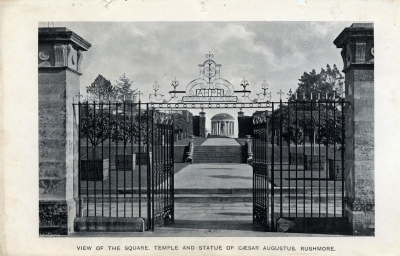
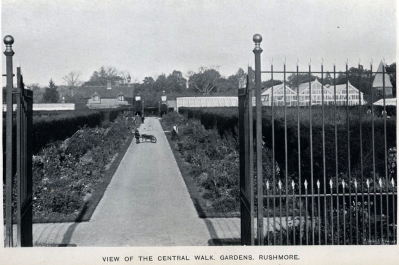
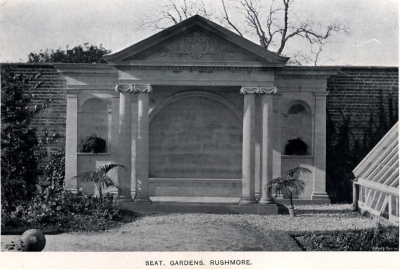
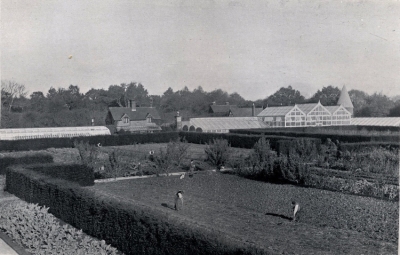
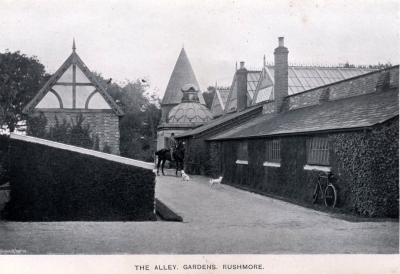
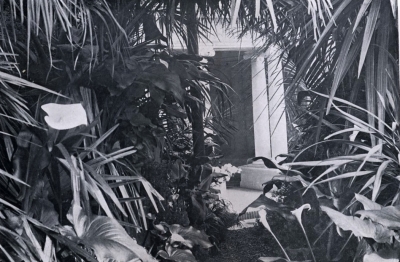
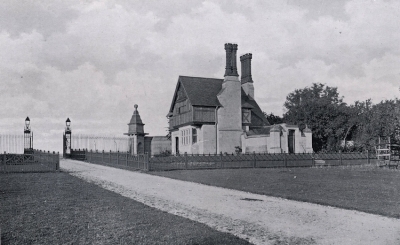
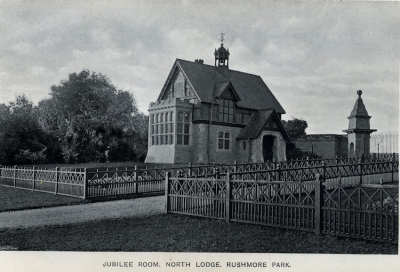
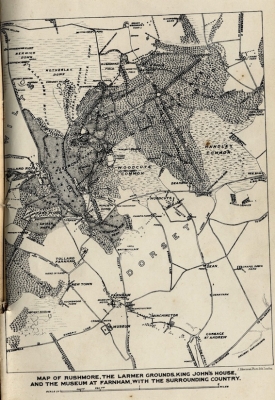
![Front of Rushmore (Sandroyd School), 2012 [Photo by R. McGoff]](../../../component/joomgallery/image/index-view=image&format=raw&type=img&id=1089&Itemid=41.html)
![Front entrance Sandroyd School (Rushmore), May 2012 [Photo by H. Davison]](../../../component/joomgallery/image/index-view=image&format=raw&type=img&id=1098&Itemid=41.html)
![Side of Rushmore (Sandroyd School), 2012 [Photo by R. McGoff]](../../../component/joomgallery/image/index-view=image&format=raw&type=img&id=1090&Itemid=41.html)


